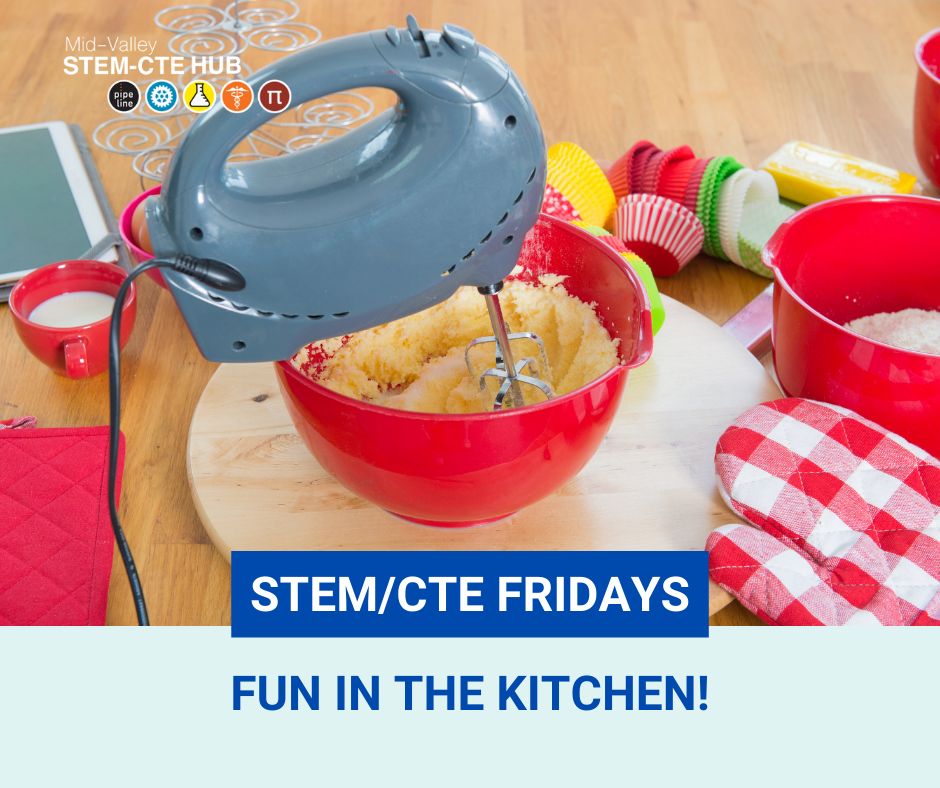We hope you’re excited about today’s #STEMCTEFridays post because we’re going to be cooking up some STEM activities in the kitchen! Cooking and STEM have a lot in common. A kitchen is no different than a science lab where you can explore and investigate all sorts of STEM topics like measurement, patterns, chemistry, cause and effect, and much more!
1. Questions (and answers) in the kitchen
STEM is all about observing, discovering, and questioning the world around us and a kitchen is a great place for asking questions. Kids will ask you plenty of questions while you are cooking. Here are a few questions you may have heard some of these questions in the kitchen?:
- Why does an apple turn brown after you cut it?
- Why do we have to dry foods, like fruits and pasta, to store them?
- How does popcorn pop?
- Why does lettuce wilt after you cut it?
- Why do onions make people cry?
Scroll down to the end of this post and you can find the answers to these questions.
2. Fun with pancakes
Whip up some pancakes and explore measurement, volume, and chemistry! Pancakes are a great introduction to simple baking because they require few ingredients, they’re hard to mess up, and they’re ready in minutes. Let your child help you measure out the ingredients. Use a glass measuring cup for liquids and a metal or plastic one for the flour and sugar. Help your child whisk the ingredients just until they’re smooth. Observe how the pancakes rise on the griddle, becoming larger than they originally were, and how bubbles form when the pancakes are ready to be flipped. Wonder aloud and question why this happens (hint: the baking powder contains hydrogen carbonate, which creates carbon dioxide—and bubbles—when heated). Maybe you’ll even want to do some additional experiments with baking soda and baking powder to learn more.
3. Experiment with cake
Did you know that baking is actually a chemical reaction? When you add heat to something and it changes, it is called an endothermic reaction. So, baking is chemistry!!
Do an experiment where you make 4 mini-cakes. Label the first cake #1 and make it with all of the ingredients. Then, go on to bake three more cakes, but with the following differences:
- For cake # 2, leave the oil out.
- For cake #3, leave the egg out.
- For cake #4, leave the baking powder out.
Here’s the recipe for the cakes. Remember, you’ll need to measure and mix this set of ingredients four times to complete all four experiments.
- 6 tablespoons flour
- 3 tablespoons sugar
- 1 pinch of salt
- 2 or 3 pinches of baking powder
- 2 tablespoons milk
- 2 tablespoons cooking oil
- ¼ teaspoon vanilla
- ⅓ of an egg (Break egg into a cup; beat until mixed, then use approximately one-third of it. Save the rest for 2 of the other cakes.
After the cakes are cooled, remove them from the pans and cut them in half. Observe the differences in size, texture, appearance, etc. They are all edible, so you can taste each one and see which tastes the best. Discuss why each cake is different and what the purpose is of each ingredient in the cake.
Answers to questions in #1
- Fruit contains a chemical enzyme that reacts with the oxygen in our air creating a rust-like effect on the surface of the apple. To stop the discoloration, place the apple slices in a bowl of water so the enzymes do not have access to oxygen. Another way is to sprinkle them with an acidic liquid like lemon juice.
- Most foods, especially fruits, contain a lot of water. This sweet water is a prime environment for the growth of bacteria and mold. To preserve the food, we need to remove the water through dehydration.
- The secret to popcorn is a tiny drop of water contained in the starch-filled kernel. Heat turns that water drop into steam, which expands and breaks the kernel’s shell open.
- Uncut lettuce is very firm and crispy. This is because lettuce is 90% water! Once the lettuce is chopped, it becomes wilted because there are more edges for the water to escape. To freshen wilted lettuce, simply soak it in a bowl of ice-cold water.
- The layers of an onion contain an irritant called sulfuric acid. Cutting releases the strong aroma of the acid. Tears are produced to wash the gaseous chemical from our eyes.
More cooking and STEM fun!
- Over 150 STEM Activities for Kids in Your Kitchen
- Make a Magic Mug Cake
- STEAM Kids in the Kitchen
- 10 Science Experiments You Can Eat with Your Kids
- 100 Amazing Food Experiments with Kids
- 28 Edible Science Projects You’ll Actually Want to Eat
- Solar Oven Smores
Check out more #STEMCTEFridays posts here!


